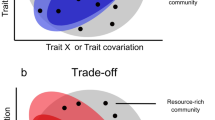Abstract
We investigated the functional and structural responses of Scots pine to climate and estimated the importance of the genotype on the traits studied. We analysed 13C isotope discrimination (Δ13C) of various provenances in a common garden experiment and gas exchange characteristics for provenances growing in their natural environment. No clear climatic trend was found in the foliar Δ13C values of common garden trees. Similar results were obtained from estimation of λ (a largely VPD, temperature and light independent measure of intrinsic water use efficiency) from the gas exchange data. The ratio of needle mass to unit stem area and branch area to stem area increased towards south in both experiments and hence, seemed to be genetic. Trees from drier and warmer conditions seemed not to have either lower needle mass or higher intrinsic water use efficiency compared to northern latitudes.
Similar content being viewed by others
Author information
Authors and Affiliations
Additional information
Received: 6 November 1998 / Accepted: 1 July 1999
Rights and permissions
About this article
Cite this article
Palmroth, S., Berninger, F., Nikinmaa, E. et al. Structural adaptation rather than water conservation was observed in Scots pine over a range of wet to dry climates. Oecologia 121, 302–309 (1999). https://doi.org/10.1007/s004420050932
Issue Date:
DOI: https://doi.org/10.1007/s004420050932




